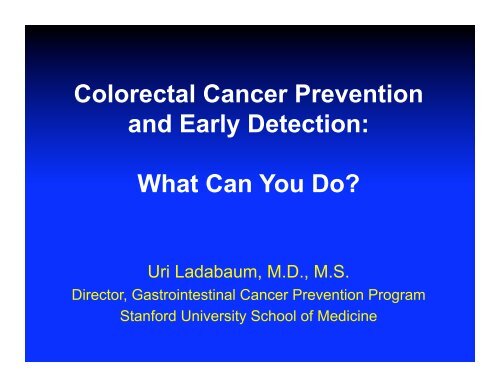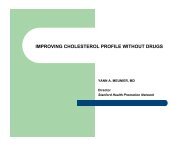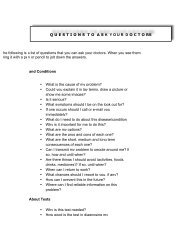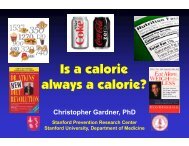PowerPoint slides - Health Improvement Program - Stanford University
PowerPoint slides - Health Improvement Program - Stanford University
PowerPoint slides - Health Improvement Program - Stanford University
Create successful ePaper yourself
Turn your PDF publications into a flip-book with our unique Google optimized e-Paper software.
Colorectal Cancer Preventionand Early Detection:What Can You Do?Uri Ladabaum, M.D., M.S.Director, Gastrointestinal Cancer Prevention <strong>Program</strong><strong>Stanford</strong> <strong>University</strong> School of Medicine
Disclosure•! The American Cancer Society is thesource for much of this material•! Uri Ladabaum, M.D., M.S. is notemployed by the American CancerSociety
2009 Estimated US Cancer Cases*Men766,130Women713,220Prostate 25%Lung & bronchus 15%Colon & rectum 10%Urinary bladder 7%Melanoma of skin 5%Non-Hodgkin 5%lymphomaKidney & renal pelvis 5%Leukemia 3%Oral cavity 3%Pancreas 3%All Other Sites 19%27% Breast14% Lung & bronchus10% Colon & rectum6% Uterine corpus4% Non-Hodgkinlymphoma4% Melanoma of skin4% Thyroid3% Kidney & renal pelvis3% Ovary3% Pancreas22% All Other Sites*Excludes basal and squamous cell skin cancers and in situ carcinomas except urinary bladder.Source: American Cancer Society, 2009.
Lifetime Probability of Developing Cancer, Men, 2003-2005*SiteRiskAll sites † 1 in 2Prostate 1 in 6Lung and bronchus 1 in 13Colon and rectum 1 in 18Urinary bladder ‡ 1 in 27Melanoma § 1 in 39Non-Hodgkin lymphoma 1 in 45Kidney 1 in 57Leukemia 1 in 67Oral Cavity 1 in 72Stomach 1 in 90* For those free of cancer at beginning of age interval.† All Sites exclude basal and squamous cell skin cancers and in situ cancers except urinary bladder.‡ Includes invasive and in situ cancer cases§ Statistic for white men.Source: DevCan: Probability of Developing or Dying of Cancer Software, Version 6.3.0 Statistical Research andApplications Branch, NCI, 2008. http://srab.cancer.gov/devcan
Lifetime Probability of Developing Cancer, Women, US, 2003-2005*SiteRiskAll sites † 1 in 3Breast 1 in 8Lung & bronchus 1 in 16Colon & rectum 1 in 20Uterine corpus 1 in 40Non-Hodgkin lymphoma 1 in 53Urinary bladder ‡ 1 in 84Melanoma § 1 in 58Ovary 1 in 72Pancreas 1 in 75Uterine cervix 1 in 145* For those free of cancer at beginning of age interval.† All Sites exclude basal and squamous cell skin cancers and in situ cancers except urinary bladder.‡ Includes invasive and in situ cancer cases§ Statistic for white women.Source: DevCan: Probability of Developing or Dying of Cancer Software, Version 6.3.0 Statistical Research andApplications Branch, NCI, 2008. http://srab.cancer.gov/devcan
commons.wikimedia.org
Trends in Consumption of Five or More Recommended Vegetableand Fruit Servings for Cancer Prevention, Adults 18 and Older,US, 1994-2007Note: Data from participating states and the District of Columbia were aggregated to represent the UnitedStates.Source: Behavioral Risk Factor Surveillance System CD-ROM (1984-1995, 1996, 1998) and Public Use Data Tape(2000, 2003, 2005, 2007), National Center for Chronic Disease Prevention and <strong>Health</strong> Promotion, Centers forDisease Control and Prevention, 1997, 1999, 2000, 2001, 2004, 2006, 2008.
Trends in Obesity* Prevalence (%), By Gender, Adults Aged 20to 74, US, 1960-2006 †*Obesity is defined as a body mass index of 30 kg/m 2 or greater. † Age adjusted to the 2000 US standard population. Source:National <strong>Health</strong> Examination Survey 1960-1962, National <strong>Health</strong> and Nutrition Examination Survey, 1971-1974, 1976-1980,1988-1994, 1999-2002, National Center for <strong>Health</strong> Statistics, Centers for Disease Control and Prevention, 2002, 2004.2003-2004, 2005-2006: National <strong>Health</strong> and Nutrition Examination Survey Public Use Data Files, 2003-2004, 2005-2006,National Center for <strong>Health</strong> Statistics, Centers for Disease Control and Prevention, 2006, 2007.
Obesity Trends* Among U.S. AdultsBRFSS, 1988(*BMI !30, or ~ 30 lbs. overweight for 5’ 4” person)No Data
Obesity Trends* Among U.S. AdultsBRFSS, 1991(*BMI !30, or ~ 30 lbs. overweight for 5’ 4” person)No Data
Obesity Trends* Among U.S. AdultsBRFSS, 1994(*BMI !30, or ~ 30 lbs. overweight for 5’ 4” person)No Data
Obesity Trends* Among U.S. AdultsBRFSS, 1997(*BMI !30, or ~ 30 lbs. overweight for 5’ 4” person)No Data
Obesity Trends* Among U.S. AdultsBRFSS, 2000(*BMI !30, or ~ 30 lbs. overweight for 5’ 4” person)No Data
Obesity Trends* Among U.S. AdultsBRFSS, 2003(*BMI !30, or ~ 30 lbs. overweight for 5’ 4” person)No Data
Obesity Trends* Among U.S. AdultsBRFSS, 2006(*BMI !30, or ~ 30 lbs. overweight for 5’ 4” person)No Data
Obesity Trends* Among U.S. AdultsBRFSS, 2008(*BMI !30, or ~ 30 lbs. overweight for 5’ 4” person)No Data
Obesity Trends* Among U.S. AdultsBRFSS, 1990, 1999, 2008(*BMI !30, or about 30 lbs. overweight for 5’4” person)199019992008No Data
Trends in Prevalence (%) of No Leisure-Time Physical Activity, byEducational Attainment, Adults 18 and Older, US, 1992-2007Adults with less than a high school educationAll adultsNote: Data from participating states and the District of Columbia were aggregated to represent the UnitedStates. Educational attainment is for adults 25 and older.Source: Behavioral Risk Factor Surveillance System CD-ROM (1984-1995, 1996, 1998) and Public Use Data Tape(2000, 2002, 2004, 2005, 2006, 2007), National Center for Chronic Disease Prevention and <strong>Health</strong> Promotion,Centers for Disease Control and Prevention, 1997, 1999, 2000, 2001, 2003, 2005, 2006, 2007, 2008.
Tobacco Use in the US, 1900-2005Per capita cigaretteconsumptionMale lung cancerdeath rateFemale lung cancerdeath rate*Age-adjusted to 2000 US standard population.Source: Death rates: US Mortality Data, 1960-2005, US Mortality Volumes, 1930-1959, National Center for <strong>Health</strong>Statistics, Centers for Disease Control and Prevention, 2006. Cigarette consumption: US Department ofAgriculture, 1900-2007.
Mammogram Prevalence (%), by Educational Attainment and<strong>Health</strong> Insurance Status, Women 40 and Older, US, 1991-2006All women 40 and olderWomen with less than a high school educationWomen with no health insurance*A mammogram within the past year. Note: Data from participating states and the District of Columbia wereaggregated to represent the United States.Source: Behavior Risk Factor Surveillance System CD-ROM (1984-1995, 1996-1997, 1998, 1999) and Public UseData Tape (2000, 2002, 2004, 2006), National Centers for Chronic Disease Prevention and <strong>Health</strong> Promotion, Centersfor Disease Control and Prevention, 1997, 1999, 2000, 2000, 2001, 2003, 2005, 2007.
Trends in Recent* Pap Test Prevalence (%), by EducationalAttainment and <strong>Health</strong> Insurance Status, Women 18 and Older,US, 1992-2006All women 18 and olderWomen with no health insuranceWomen with less than a high school education* A Pap test within the past three years. Note: Data from participating states and the District of Columbiawere aggregated to represent the United States. Educational attainment is for women 25 and older.Source: Behavior Risk Factor Surveillance System CD-ROM (1984-1995, 1996-1997, 1998, 1999) and PublicUse Data Tape (2000, 2002, 2004, 2006), National Center for Chronic Disease Prevention and <strong>Health</strong>Promotion, Center for Disease Control and Prevention, 1997, 1999, 2000, 2000, 2001, 2003, 2005, 2007.
Trends in Recent* Flexible Sigmoidoscopy or ColonoscopyPrevalence (%), by Educational Attainment and <strong>Health</strong> InsuranceStatus, Adults 50 Years and Older, US, 1997-2006*A flexible sigmoidoscopy or colonoscopy within the past ten years. Note: Data from participating states and theDistrict of Columbia were aggregated to represent the United States.Source: Behavioral Risk Factor Surveillance System CD-ROM (1996-1997, 1999) and Public Use Data Tape (2001,2002, 2004, 2006), National Center for Chronic Disease Prevention and <strong>Health</strong> Promotion, Centers for Disease Controland Prevention and Prevention, 1999, 2000, 2002, 2003, 2005, 2007.
THANK YOU!Remember:Speak with your doctor andfamily about getting screened!





